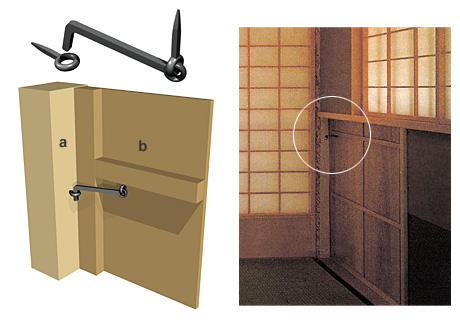|
||
 |
||
1@Rojizai tsurikan F©έήθa. An assemblage for hanging a kettle composed of a metal ring, circular and square washers, maruza Ϋΐ; and kakuza pΐ, and a pin *sen π.
2@Tsurihana hirukan ήΤgθa. An assemblage for hanging flower vases including an eyelet, round and square washers and a pin.
3@Tsukiagemado-no-sao ΛγΜΖ. A short prop about 20cm long to hold open the window that is cut in the sloping part of the ceiling in a tea ceremony house. The hardware needed includes a wooden hooked nail, usually cedar, and a nail with an eye hole that has a round washer. This is attached to the bottom of the window opening and holds the prop.
4@Nijiriguchi kakegane ηWϋ|ΰ. Two socket hinges, two round washers and a hook-latch used to secure the doors of a crawl-in entrance *nijiriguchi ηWϋ.

nijiriguchi
kakegane ηWϋ|ΰF a) *hashira @b) *nijiriguchi ηWϋ
@
(C)2001 Japanese Architecture and Art Net Users System.@No reproduction or republication without written permission.
fΪΜeLXgEΚ^ECXgΘΗASΔΜRecΜ³f‘»E]ΪπΦΆά·B

